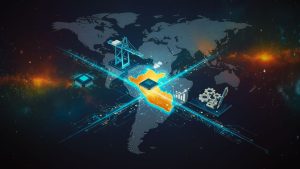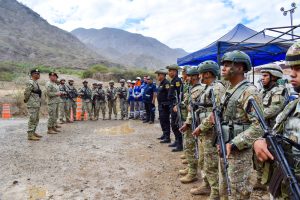Summary
As the digital dimension is becoming more deeply integrated into society, it is also becoming more integrated into military operations, as the advance of various threats and vulnerabilities in cyberspace is identified, which, if not managed, can compromise a country’s critical assets. Given this scenario, the adoption of emerging technologies such as Artificial Intelligence (AI), is presented as a strategic element for national security from the field of cyber defense. This article explores the impact and potential of AI in cyber defense, highlighting its crucial role in protecting digital assets and strengthening military capabilities in an increasingly digitized world. It examines how AI enables task automation and improves cyber threat response, as well as its application in areas such as pattern recognition, decision making and logistics. However, for developing countries to take full advantage of these technologies, it is essential to take a holistic approach that combines the acquisition of advanced tools with appropriate training and experimentation.
Keywords: AI, cyber defense, cyber defense capabilities, cyberspace, algorithm.
Introduction
Understanding the challenges of defense in the cyberspace dimension requires a cohesive vision between safeguarding critical assets and national interests and the intangible risks of the inadequate implementation of technology beyond the internet or the commonly mentioned AI. The internet is a communication medium that integrates various wired and wireless technologies for data transmission. Through it, citizens share and access information and exercise certain constitutional duties and rights. Currently, more than 5,440 million people around the world use the Internet, which is equivalent to approximately 67.1% of the world’s population, when in 2010 it was equivalent to only 27.5%. [1]
Increased access to the Internet has boosted the development of services in the financial and educational sectors, proving its value at critical moments such as the pandemic. However, its most outstanding feature is that, as its accessibility has increased, its use has become progressively more relevant in different sectors of society. It is not just an additional dimension; in many areas it is essential for the maintenance and operation of services and has become the medium that supports key areas of activity for citizens.
In addition, it should be considered that the Internet represents the environment in which various technological innovations, including AI, are deployed and fed back. This technology has demonstrated in a short time a remarkable potential in multiple applications, both for improving the productive and administrative capabilities of organizations and for its use for malicious purposes in digital spaces. This situation has raised among academics and authorities several questions about the role of AI in the protection of countries from cyber defense, an increasingly critical area for national security and development. Being a data and internet intensive technology in constant development, it is necessary to have a comprehensive understanding of its capabilities and scope to ensure optimal use. In this regard, the objective of this article is to examine the relationship and role of AI in cyber defense.
The Digital Dimension
Phenomena such as globalization have driven the adoption of standards and practices of governance and legislation at the international level, such as the digitization of services and digital transformation. The advancement of these trends seeks to optimize the integration of digital resources to improve the efficiency of various processes in the public and private sector. This transition differs greatly between countries and sectors, but it has been proven how digital spaces and resources have undergone a significant evolution, expanding the options and possible activities for users. This change has resulted in the massification of platforms and greater integration of digital tools in multiple activities. An example of the increase in the complexity of online activity is the growing amount of data generated and processed on the Internet.
In 2015, the volume of data created and processed globally was 15.5 zettabytes (unit equivalent to one billion terabytes), and it is estimated that by 2025 this figure will exceed 180 zettabytes.[2] This dramatic increase reflects the increasingly critical role of the Internet in the execution of millions of tasks, consolidating it as an integral component of modern society. [3]
Thus, the safeguarding of digital assets such as databases, digital files, web pages, interconnected systems, among others, involves various challenges in terms of security, which go beyond the traditional protection of physical elements.[4]
Thus, the digital dimension represents a space where critical digital assets, users, private entities and possible malicious agents are connected, which can lead to interactions that represent a danger to the population, organizations or society as a whole. A key concept to dimension the scope of these risks is cyberspace, which is defined as the set of interconnected and interdependent networks of information technology infrastructure (…) together with the people who interact with them[5] . This constitutes a new domain of security operations for countries, due to the existence and sophistication of various digital threats that can cause considerable damage to a country.
In the public sector, for example, an action that compromises critical data, a system or remote access to a device can cause the chained interruption of different processes.[6] Recognizing the need to protect these elements is the first step in identifying and addressing a country’s digital vulnerabilities, an aspect of particular importance in developing nations, such as those in Latin America. Neglecting this dimension of security makes these countries increasingly vulnerable targets for cyber threats that have evolved almost in tandem with the Internet. Although these cyberthreats initially focused on first world nations, they now have a global and widespread presence. By taking advantage of the anonymity of online activity and increased connectivity, cyber attacks can come from any location, making attribution and investigation of attacks significantly more difficult. TABLE 1 below presents a summary of some cyberattack cases.
TABLE 1. Cases of cyber-attacks at the international level
| Cyberattack | Date | Description |
| Cyberattack on Estonia | 2007 | Estonia suffered a series of massive cyber-attacks that impacted the government, banks and the media. This event is known as the first case in which a country suffered a large-scale cyberattack affecting critical infrastructure.[7] |
| Stuxnet and the infection of centrifuges | 2010 | Stuxnet was a malicious program that infected centrifuges at a nuclear power plant in Iran for months while sabotaging them and camouflaging the malfunction with altered data. [8] |
| “Red October”: international theft of information from institutions | October, 2012 | It was discovered that the “Rocra” virus exploited vulnerabilities in Windows Office and infiltrated e-mails, stealing sensitive and encrypted documents from various public institutions internationally, especially in Europe, Central Asia and North America, for more than five years.[9] |
| Attack on the U.S. Office of Personnel Management (OPM).
|
June, 2015 | Personal information on nearly four million federal employees was stolen, including bank details and details of training received.[10] |
| WannaCry virus massive cyber attack | May, 2017 | The massive cyber attack using the malicious software “Ransom:Win32.WannaCrypt”, known as WannaCry, blocked access to the computer systems of state institutions and companies around the world, infecting more than 200,000 computers in 150 countries.[11] |
| Cyberattack on the Government of Costa Rica | April, 2022 | Ransomware attacks carried out by the Russian group Conti affected several government institutions, paralyzing key services and causing serious disruptions in public administration. This situation led to the country becoming the first nation to declare a state of emergency due to a cyberattack[12] . |
Source: Prepared by the author
Cyber defense and AI
Cyber defense represents the “military capacity to act against threats or attacks carried out in and through cyberspace when they affect national security”.[13] In the current highly digitalized scenario, it is necessary not only to acquire new equipment and strengthen institutional capabilities, but also to develop agile teams to explore the potential of new technologies and establish a laboratory of cyber capabilities in defense. Among the technologies to be considered for this strengthening and innovation is AI.
AI is a discipline specializing in the development of algorithms capable of executing tasks that would require human intelligence, such as pattern recognition, decision making or natural language understanding.[14] This technology has evolved from simple search and problem-solving algorithms to complex systems that process large volumes of data to produce more sophisticated and accurate answers. Following the November 2022 release of ChatGPT, a chatbot that responds almost coherently to text-based queries, the race to develop “everything with AI” has heated up.
Generative AI, capable of producing different types of content (text, images, videos, among others), is one of the most widespread and is expected to impact all industries, adding billions of dollars in value to the global economy through productivity in areas such as marketing, customer service, sales and R&D[15] . Just as AI shows versatility in the development of new digital services, it also offers new capabilities for cyber defense and cyberspace protection, and even in the field of military operations.
Deep learning is one of the areas of AI that has driven image recognition, also known as computer vision, and natural language processing.[16] These key disciplines within AI focus on the interpretation of visual and textual data, respectively. The development of these fields has enabled significant advances in other security-related technological fields, such as biometric identification, which has become a more accessible and accurate technology for user identity verification.[17]
The integration of AI for defense represents a step aligned with the digital transformation that institutions and elements of the public sector are undergoing globally, both to leverage the benefits of technologies and to not be outpaced in terms of capabilities.[18] In highly digitized countries, the implementation of AI in cybersecurity is seen as a natural extension of established infrastructures.[19] In contrast, in less digitized regions, AI adoption can play a crucial role in building robust security systems and practices in relation to the digital dimension.[20] There are various applications of AI in cyber defense. For example, task automation frees up human resources to focus on more complex and strategic problems, while improving the ability to detect, prevent and respond to potential threats more efficiently and effectively.
Eric Horvitz, Chief Scientist at Microsoft,[21] highlighted the use of AI in cybersecurity to assist staff in preventing and detecting malware, processing information and identifying false positives in security alerts. This integration is done through machine learning algorithms and real-time data processing, supporting the monitoring and review of different channels, such as documentation, machine operation or emails. This adds an additional layer of security by detecting patterns that might go unnoticed by humans.
On the other hand, modern weapon design includes AI components to improve accuracy or data collection and processing. From intelligence analysis to the deployment of autonomous systems, such as drones or vehicles, AI enhances defensive and offensive capabilities on the battlefield.[22] AI systems can enhance surveillance and reconnaissance capabilities, allowing military and intelligence agencies to analyze imagery and video with greater speed and accuracy than is possible with traditional review.[23] For example, computer vision is used to identify and track suspicious movements in real time.
In this line, the United States (US) Army has implemented, since 2017, an AI system known as “Project Maven”, focused on helping intelligence analysts of the US Special Operations Command to identify objects in the videos of small ScanEagle drones.[24] In Spain, the Ministry of Defense considers it relevant, as a way to optimize the military use of AI, to “sensorize” the soldier, vehicles and environmental information gathering systems, such as a weather station, in order to capture relevant information on the physical and mental state of each soldier, the environment, audio and image, as well as scenario conditions, such as weather and geography.[25] The versatility of these AI solutions allows them to be used even in military training or practice sessions, which not only helps teams adapt to their operation and obtain more accurate results for decision-making, but also makes it possible to test the limits of AI and provide feedback.
In May 2021, AI was used, for the first time, in a British Army operation, during the Spring Storm exercises, where soldiers from the UK’s 20th Armored Infantry Brigade tested a machine learning engine designed to process large amounts of complex data, including information about the environment and terrain. This system offered a significant reduction in planning time compared to human equipment, while producing results of equal or higher quality. [26]
Finally, AI also has relevant applications for military logistics by improving supply chain efficiency and visibility. One example is the use of AI for predictive maintenance in the U.S. Army, where it has been able to predict equipment failures with 75% to 90% accuracy, enabling proactive maintenance and reduced downtime.[27] In addition, the U.S. Navy has integrated predictive analytics tools and digital twin models to anticipate supply chain disruptions, improving responsiveness in conflict situations.[28] These advances enable more effective resource management and more agile planning in the face of operational challenges.
It should be remembered that the acquisition of these technologies is only the first step; advance training and experimentation are needed to be able to manage incidents in cyberspace in a timely manner.
Conclusions
When considering the advancement and role of the digital dimension in today’s society, AI represents a high-value element for cyber defense, as it enables the automation of tasks and improves the ability to respond to cyber threats. The integration of AI in defense systems not only optimizes the protection of digital assets, but also boosts offensive and defensive capabilities in the military field, excelling in areas such as pattern recognition, real-time decision making and predictive logistics. However, the effective adoption of these technologies requires a holistic approach that includes not only the acquisition of advanced tools, but also the development of appropriate skills and strategies for their implementation. In this regard, developing countries should prioritize training and experimentation with AI so as not to be left behind in the field of cyber defense. In this way, AI, with its potential to transform defense operations, presents a critical opportunity to bolster national security capabilities, provided it is approached with the necessary preparation and vision.
Endnotes:
- Kemp, Simon. Digital 2024 April Global Statshot Report. DataReportal, 2024. https://datareportal.com/reports/digital-2024-april-global-statshot. ↑
- Taylor, P. “Amount of data Created, Consumed, and Stored 2010-2020, with Forecasts to 2025.” Statista, 2023. https://www.statista.com/statistics/871513/worldwide-data-created/ ↑
- Laskar, M. H. “Examining the Emergence of Digital Society and the Digital divide in India: A comparative Evaluation Between Urban and Rural Areas.” Frontiers in Sociology 8 (2023) https://doi.org/10.3389/fsoc.2023.1145221 ↑
- Vargas, F. “Third Chapter – Global Challenges and Trends for the Transformation of Security and Defense Institutions”. In Brújula Hemisférica: Desarrollo de Capacidades Prospectivas y Estudios de Futuros para las decisiones en Seguridad de América Latina, edited by J. Avalos, 153-216. Centro de Estudios Superiores Navales – Instituto de Investigaciones Estratégicas de la Armada de México. 2023. ↑
- El Peruano. “Decreto Supremo que Aproueba el Reglamento de la Ley No 30999, Ley de Ciberdefensa”. 2024. https://busquedas.elperuano.pe/dispositivo/NL/2261522-1 ↑
- Linares, F., & Contreras, K. “State Presence and Digital Services Platform.” Journal of Defense Science and Research 4, no. 2, (2023): 19-36. https://doi.org/10.58211/recide.v4i2.103. ↑
- BBC. “How a Cyber Attack Transformed Estonia.” 2017. https://www.bbc.com/news/39655415 ↑
- Zetter, K. Countdown to Zero Day: Stuxnet and the Launch of the World’s First Digital Weapon. New York: Crown Publishers ↑
- Wünsch, S., & Machhaus, C. “Red October Attacks Computers Worldwide.” DW, 2013. https://www.dw.com/es/octubre-rojo-ataca-a-computadoras-en-todo-el-mundo/a-16525533 ↑
- The World. “Cyber Attack Compromises Data of Millions of U.S. Government Employees.” 2015. International. https://www.elmundo.es/internacional/2015/06/05/5570e5cce2704e635b8b4592.html ↑
- BBC. “Massive Cyberattack: Who Were the Countries and Institutions Most Affected by the WannaCry Virus?” 2017. https://www.bbc.com/mundo/noticias-39929920 ↑
- Americas Quarterly. “The Dramatic Cyberattack that Put Latin America on Alert.” 2023. https://americasquarterly.org/article/el-dramatico-ciberataque-que-puso-a-america-latina-en-alerta/ ↑
- Ministry of Defense of Peru. Política Nacional Multisectorial de Seguridad y Defensa Nacional al 2030. 2022. https://www.gob.pe/institucion/mindef/informes-publicaciones/3212559-politica-nacional-multisectorial-de-seguridad-y-defensa-nacional-al-2030 ↑
- Russell, S., & Norvig, P. Artificial Intelligence: A Modern Approach. 4th ed. Pearson, 2020. ↑
- McKinsey & Company. “The Economic Potential of Generative AI: The Next Productivity Frontier.” 2023. https://www.mckinsey.com/capabilities/mckinsey-digital/our-insights/the-economic-potential-of-generative-ai-the-next-productivity-frontier ↑
- LeCun, Y., Bengio, Y., & Hinton, G. “Deep Learning.” Nature 521, no. 7553 (2015): 436-444. https://doi.org/10.1038/nature14539 ↑
- Linares, F., Contreras, K, & Salazar, B. “Strategic Potential of Biometrics in National Security.” Scientific Journal Security and Development 2, no. 1 (2024): 35-45. 2024. https://doi.org/10.58211/syd.v2i1.16 ↑
- Linares, F., & Contreras, K. “State Presence and Digital Services Platform.” Journal of Defense Science and Research 4, no. 2 (2023): 19-36. https://doi.org/10.58211/recide.v4i2.103. ↑
- Brynjolfsson, E., & McAfee, A. The Second Machine Age: Work, Progress, and Prosperity in a Time of Brilliant Technologies. New York: W. W. Norton & Company, 2014. ↑
- Cuba, J.C. “Artificial Intelligence in National Security: Legal Limits”. In Strategic Environment 2021: Security, Development and National Defense, edited by Vera, 25-36. CAEN-EPG & CEEEP, 2021. https://ceeep.mil.pe/2021/12/17/ambiente-estrategico-2021-seguridad-desarrollo-y-defensa-nacional/ ↑
- Microsoft. “Applications for Artificial Intelligence in Department of Defense Cyber Missions”. 2022. https://blogs.microsoft.com/on-the-issues/2022/05/03/artificial-intelligence-department-of-defense-cyber-missions/ ↑
- Gray, M., & Ertan A. Artificial Intelligence and Autonomy in the Military: An Overview of NATO Member States’ Strategies and Deployment. NATO Cooperative Cyber Defence Centre of Excellence, 2021. https://ccdcoe.org/library/publications/artificial-intelligence-and-autonomy-in-the-military-an-overview-of-nato-member-states-strategies-and-deployment/ ↑
- Geist, E., & Lohn, A. J. How Might Artificial Intelligence Affect the Risk of Nuclear War? RAND Corporation, 2018. https://www.rand.org/pubs/perspectives/PE296.html ↑
- Weisgerber, M. “The Pentagon’s New Artificial Intelligence Is Already Hunting Terrorists.” Defense One, 2018. https://www.defenseone.com/technology/2017/12/pentagons-new-artificial-intelligence-already-hunting-terrorists/144742/. ↑
- Spanish Ministry of Defense. Military Uses of Artificial Intelligence, Automation and Robotics (IAA&R). 2020. https://publicaciones.defensa.gob.es/usos-militares-de-la-inteligencia-artificial-la-automatizacion-y-la-robotica-iaa-r-libros-ebook.html ↑
- Ministry of Defense. Defence Artificial Intelligence Strategy. Gov.uk, 2022. https://www.gov.uk/government/publications/defence-artificial-intelligence-strategy/defence-artificial-intelligence-strategy. ↑
- Polowczyk, J., & Futcher, F. “Four Actions to Modernize Military Logistics and Supply Chain Security.” EY, 2022. https://www.ey.com/en_us/insights/strategy/four-actions-to-modernize-military-logistics-and-supply-chain-security ↑
- Ibid. ↑







